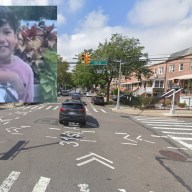By Michelle Han
The city last week unveiled its first planned steps toward making Queens Boulevard safer for pedestrians in Forest Hills and Rego Park, but the area's residents and elected officials were skeptical those promises would ever come to fruition.
Queens Boulevard, they say, is a nightmare for mothers pushing strollers, the elderly, or just about anyone who tries to cross the thoroughfare, which in certain places is 12 lanes wide.
And although the city has been studying the boulevard between the Long Island Expressway and Union Turnpike for years with the intention of making improvements, little has been done, critics say.
In a presentation at the Jan. 26 meeting of Community Board 6, which covers Forest Hills and Rego Park, representatives of the city's Transportation, Design and Construction, and Planning departments said several improvements to Queens Boulevard, such as the repainting of crosswalks and the addition of more signs, would take place as soon as weather permits.
“It was a very extensive study,” said Linda Stuurnam of the city's Planning Department, which helped conduct the study. “We have gotten to the point where we are getting to implement some of the recommendations of the study.”
She said improvements known as a “phase one” project will involve only the area from 67th Road to 70th Road, which had been identified as a pedestrian hot spot. In that area, the city will install two new traffic lights, one at 68th Avenue and one at 70th Road.
The city will also install pedestrian barriers with flower planters at portions between Eliot Avenue and Union Turnpike, Stuurnam said.
On hearing the promise of planters, City Councilwoman Karen Koslowitz (D-Forest Hills) unleashed a tirade of accusations against the Department of Transportation for dragging its feet and reneging on promises, even after she and Borough President Claire Shulman had appropriated millions to implement changes.
“In six years, there could have been a lot of lives saved if the DOT had gotten its act together,” she said.
A Brooklyn man was killed crossing the boulevard near 72nd Drive on New Year's Eve. According to Koslowitz's office, six pedestrians were killed on Queens Boulevard in 1999, six were killed in 1998, and 12 were killed in 1997.
A recent survey by state Assemblyman Michael Cohen's (D-Forest Hills) office said 103 people were involved in pedestrian accidents on Queens Boulevard, though not all were fatal, from 1997 through 1999.
Koslowitz said a representative from the Department of Transportation promised years ago that planters would be installed to act as pedestrian barriers between crosswalks, a feature seen on Manhattan's Park Avenue that forces people to cross the street only at designated intersections with traffic lights.
“We saw the pictures, we saw the planters, they were real,” Koslowitz said. “Why would I put a million dollars in the budget in June – and it was for planters, it says 'planters' – for something that wasn't even real? I want my million dollars back.”
Tony Polio of the city Department of Design and Construction said the work would begin this year.
“We're designing the planters,” he said.
By April, he said, all testing for infrastructure and all designs for the phase one project should be complete. The project will be advertised for bids, and work could begin by July and be completed three months later, he said, although he qualified his time frame by calling it an “optimistic schedule.”
In addition to the traffic lights, the project calls for planters along a pedestrian barrier and possibly additional merge-in and -out lanes to enable vehicles to turn at the intersections.
The promises of improvements did little to assuage the concerns of Forest Hills resident Bob Previdi, who demanded to know why traffic signals did not give adequate time for pedestrians to cross Queens Boulevard.
“We're a pedestrian community,” he said. “Pedestrian safety should be paramount.”

































